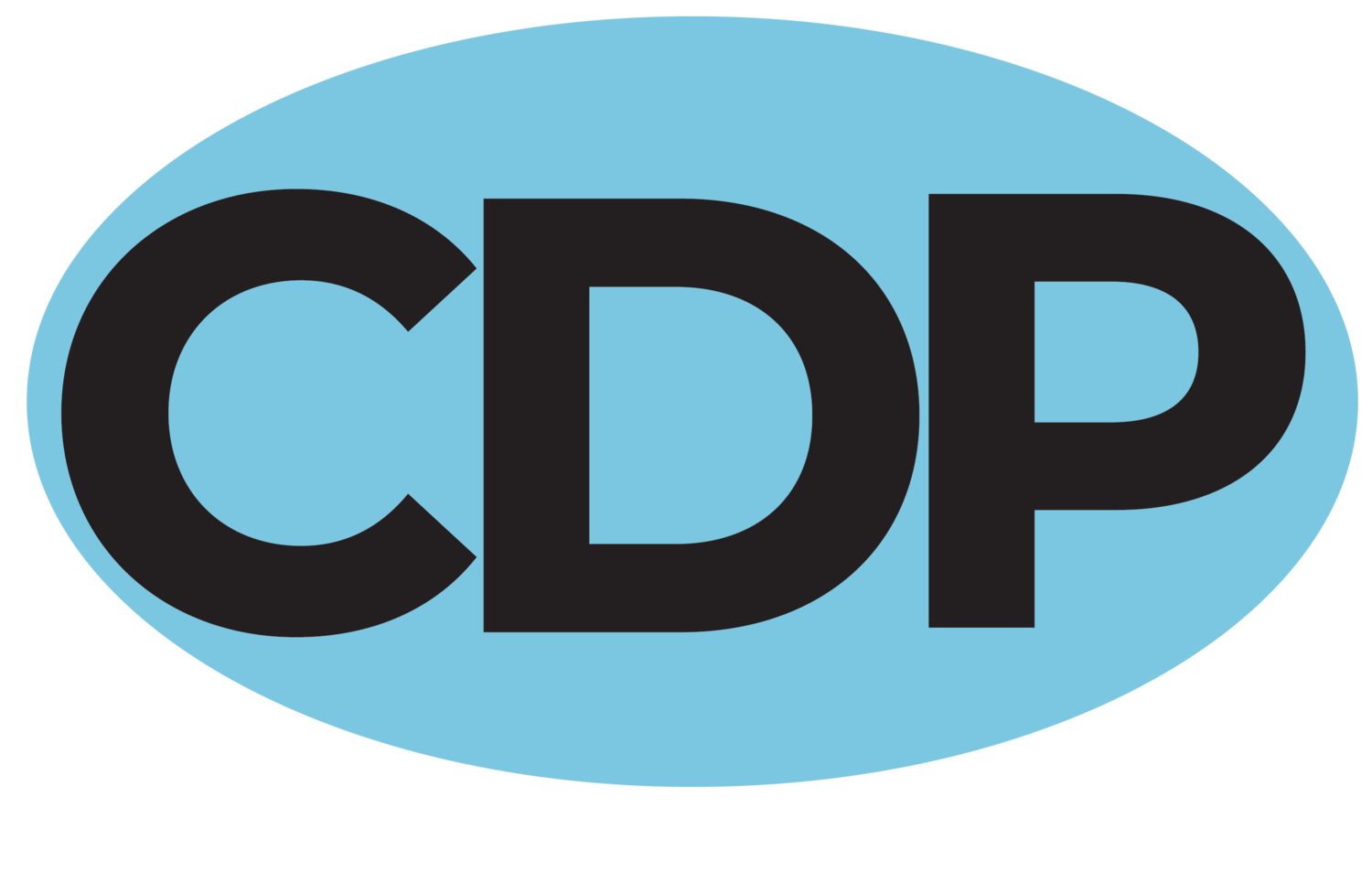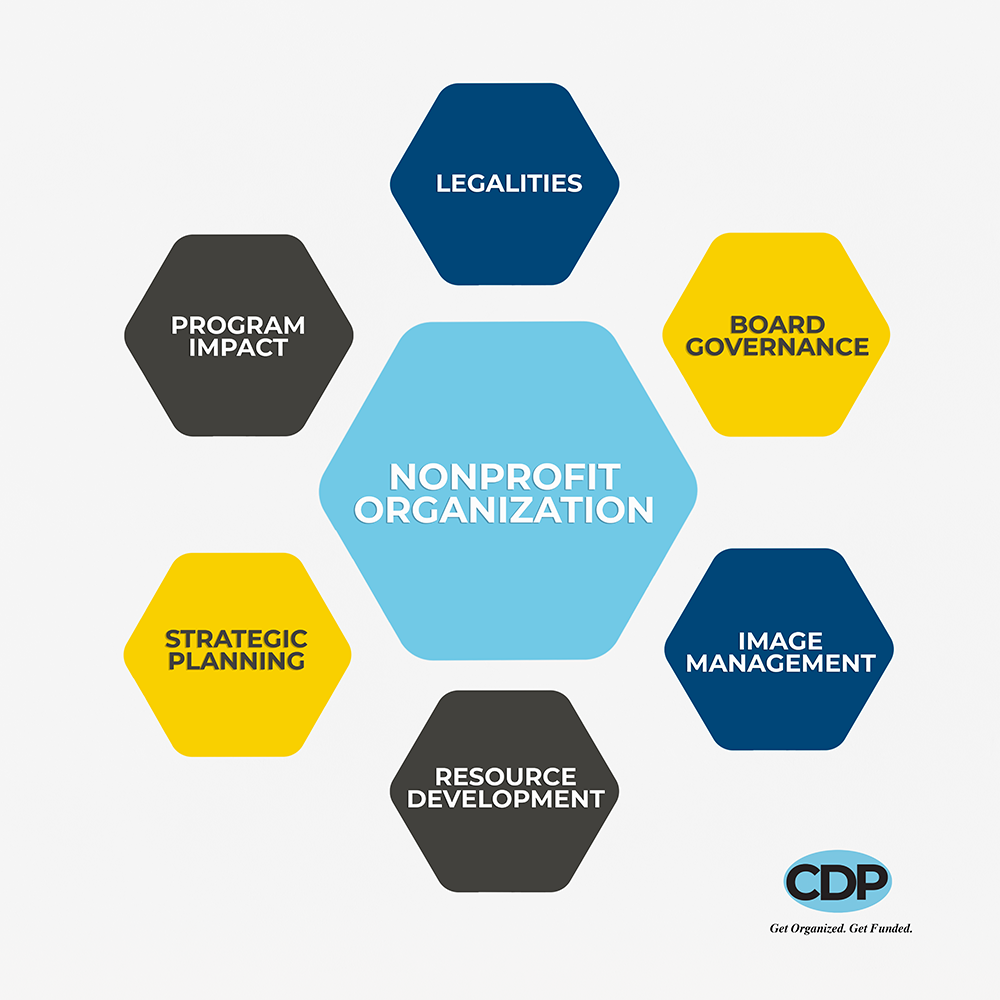Six Components of Nonprofit Organization Development
We love Nonprofits! When we begin working with any organization, we begin by doing a survey of the Six Components of Nonprofit Organizational Development. We are very strong proponent for every Nonprofit having, knowing and owning their mission. This is most certainly our top priority here at CDP. Below is a brief overview of these six components.
Our goal is to help grow and nurture viable communities and one of the key ways we do this is by helping a Nonprofit stick around for a long time — what we call “long-term sustainability”. When we talk about strengthening Nonprofits, our goal is doing that in a strategic way that will help every Nonprofit stay around for a long time.
We use this graphic to illustrate the six components and to assist Nonprofits with organizing and categorizing in every area. As Nonprofits grow, these six components will help give context and build a system that will grow with the organization. The idea is that all six components need to be in balance and ALL of them are important. There’s not one area that is more important than the others when it comes to have a sustainable organization.
Legalities incorporates the legal parts — the federal, state and local laws that we have to follow, but it also includes all of our reporting mechanisms. If we are a 501(c)(3) we need to be reporting to the IRS every year. Perhaps we should be reporting to the states that we are in — some states require that, some do not. Keeping our Legalities means that we are doing everything we know we need to do in order to keep our 501(c)(3) in good standing and that we have all of the organization’s legal matters taken care of.
There are others ways to incorporate as a Nonprofit, but the main area we work in is with 501(c)(3). According the the IRS, “The organization must not be organized or operated for the benefit of private interests, and no part of a section 501(c)(3) organization's net earnings may inure to the benefit of any private shareholder or individual (http://www.irs.gov).” Nonprofits are organized as a public benefit.
Legalities also includes our HR policies. Do we have good, strong fiscal controls? How are our internal controls? With regards to our finances, are we making sure we have good policies in place? Do we have the insurance coverage that we need? All of the above and more is included in this component of Legalities.
Board Governance is a term we use for everything that is related to the Board. Every Nonprofit has to have a Board of Directors. How do we onboard new Board Members? How do we recruit them? How do we orient them? Do they understand their roles and responsibilities? Are they fulfilling the duties that they are required to do as Board Members? When we talk about Board Governance, it’s making sure that the Board is operating the way they should and that they do it well. That they understand their legal and ethical responsibilities. The Board is the group of people legally charged with responsibility to govern an organization and they are critical to the long-term health of a Nonprofit. CDP offers a lot of training around this very important component.
Image Management for us includes PR and marketing. We define Image Management as controlling how others view our organization. We begin by defining our target audience — our area of impact, who we serve and where we network. We invest in our branding, our logo and marketing materials. We develop a plan for marketing, including our social media posts — any method or means of talking about our organization. This also includes our emails, newsletters, or our annual reports. Anything that is being distributed to the our supporters or to the public that provides information about who we are or what we do. Newspapers, media relations, networking — everything about the public face of our organization falls under Image Management.
An Image Management Plan is a strategic and systematic plan for controlling the organization’s image in the community.
Resource Development, as we define it, is really getting the people, the money and the stuff that you need to do your work. When we talk about resources, we aren’t just limiting that to money, although money is an important part of our resources and grants can be a part of that. Resources are also the people that you need, the volunteers that you need to run your organization, as well as in-kind services or in-kind donations that can help you do your work in the Nonprofit sector.
Resource Development is critical. As important as it is, sometimes Resource Development is not the source of our issues as a Nonprofit, but perhaps it’s really an indicator of where we may be falling short in some of the other six-component areas. Simply put, resources are just important. We need them in order to do our work. Resource Development is anything that involves money, volunteers, or in-kind donations that can help you do your work in the nonprofit sector.
Next we introduce the idea of Strategic Planning. When we talk about Strategic Planning, we are talking about the actual plan for the next 3 to 5 years, but we are also compelled to recognize that we need a vision — the big picture. This includes having a clear mission for our Nonprofit and knowing where we’re headed.
What lane are we in? What is our core value? What are the values that define who we are?
Answers to all of these questions have a foundational responsibility to be laid out, so that then when we walk the next stretch of road, which is the Strategic Plan, we know where we’re headed. We understand what lane we operate in and how we’re going to build our core values in order to accomplish our work. So Strategic Planning involves using our vision, mission and core values to build the next three to five year plan.
Program Impact is where we, as Nonprofits, tend to spend a lot of our time and energy, because that’s the mission-driven part of our work. Program Impact contains the programs and the services that we provide. When we’re looking at Program Impact, we are making sure that the programs we provide are done with excellence, doing what we designed them to do, as well as making sure that we, as an organization, have a method and a metric to measure just that — our program’s effectiveness. Are we using good data management? Have we implemented data collection in the programs that we are developing and implementing? Are we accomplishing the work that we set out to accomplish?
All six of these components work together. They are all important. They need their own attention. They operate together to make sure we have long-term sustainability with our Nonprofit.
When working with Nonprofits, Community Development Professionals will always keep the Six Components of Nonprofit Organization Development in front of our clients to help everyone stay focused on the mission.
What three actions can I take over the next thirty days to consider how I might move my idea or Nonprofit forward?
If your organization needs help in one or any of these six areas, or you want to learn more about Nonprofit Organizational Development, we offer a training in our CDP Training Academy called, “Nonprofit Organizational Development: The Basics” for only $69. You can find out more here: https://tinyl.io/7C4o



